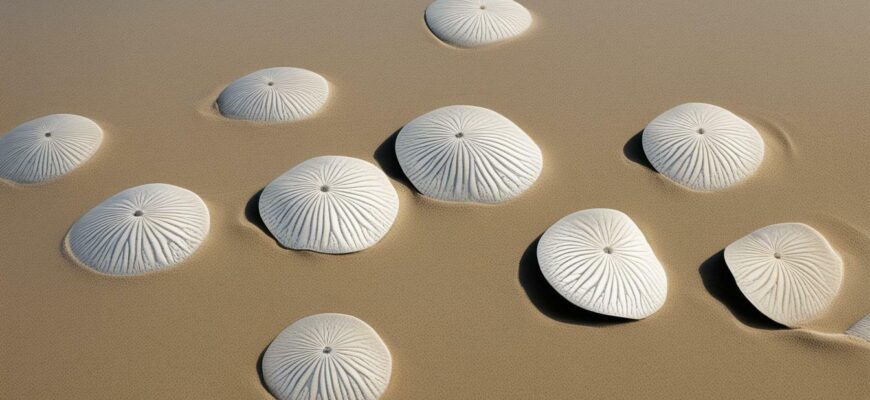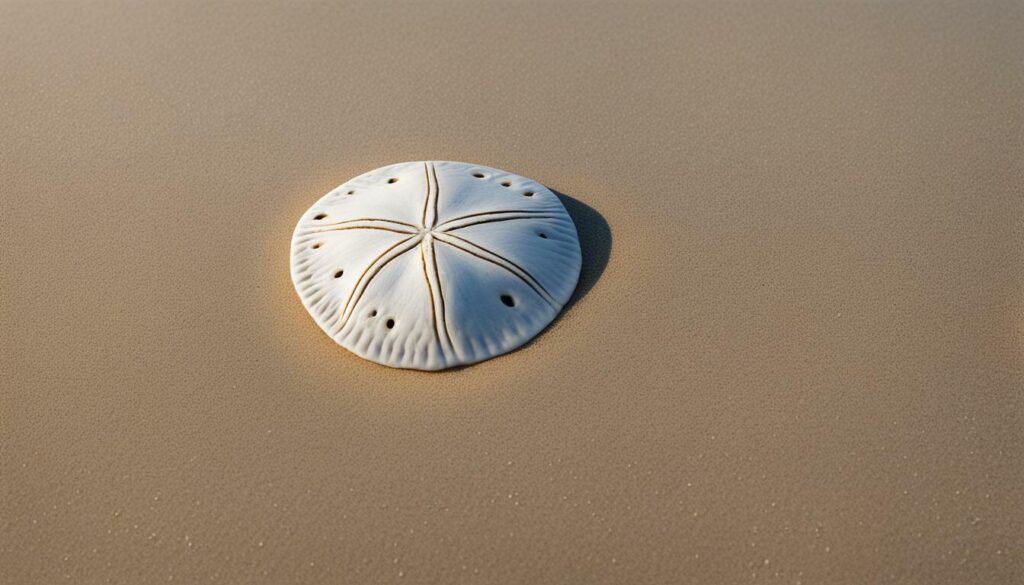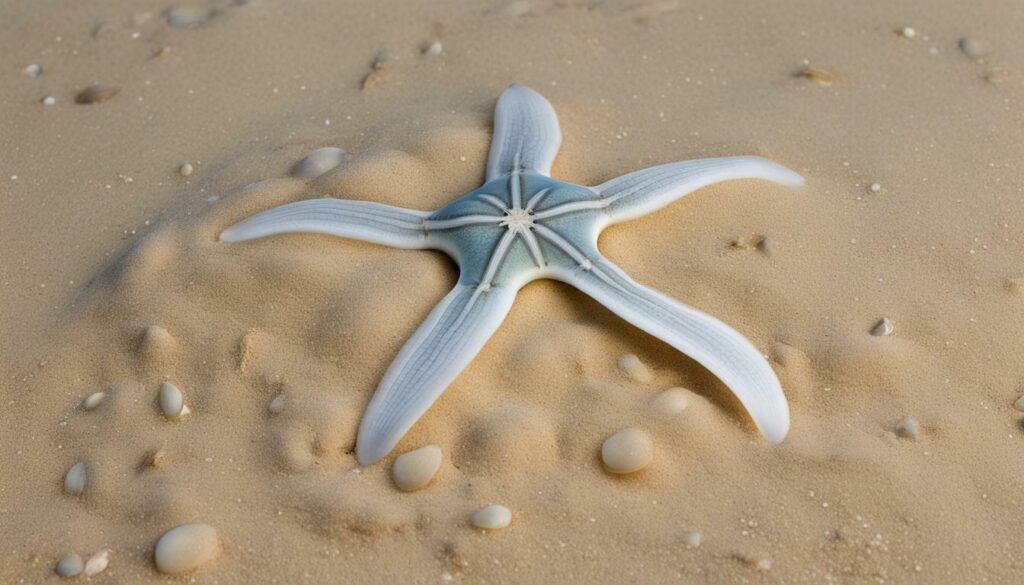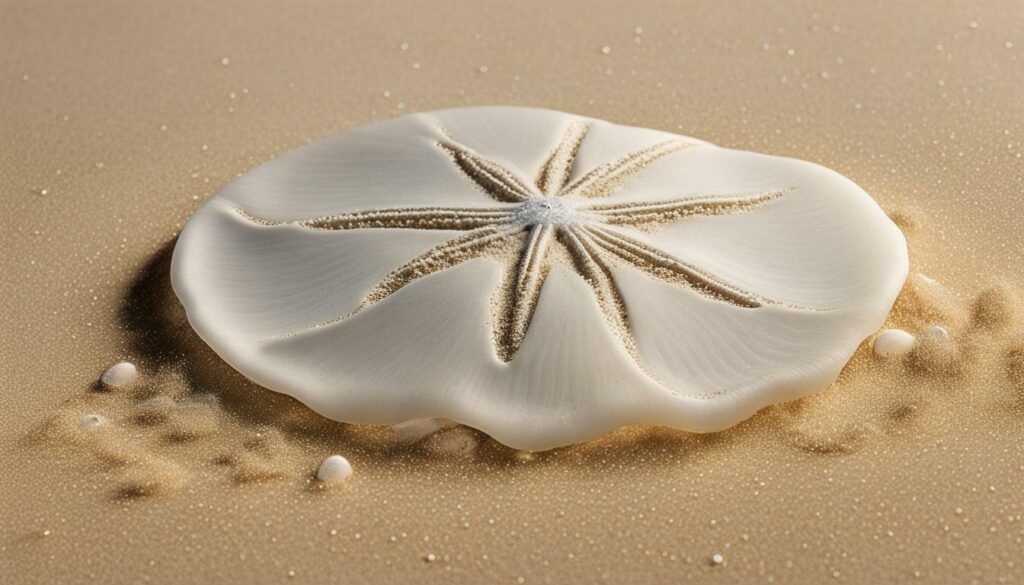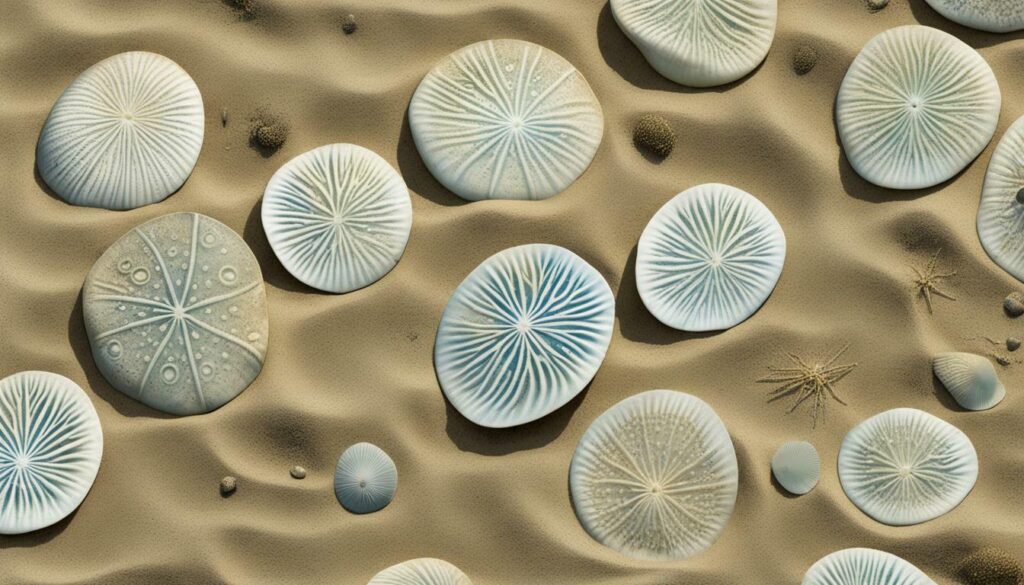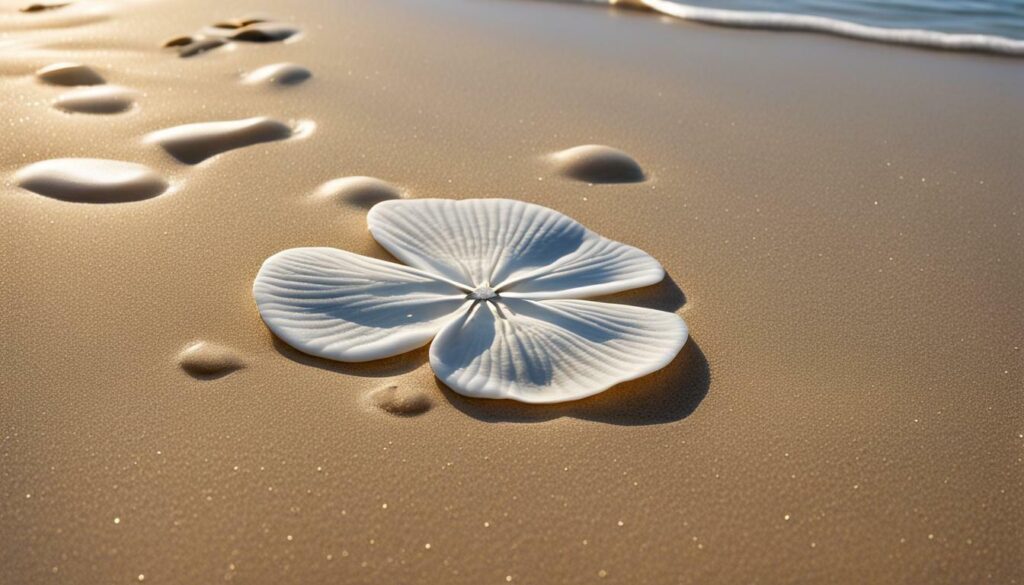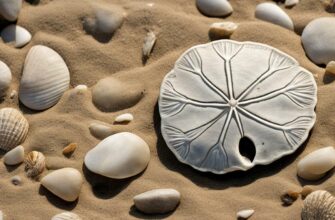Have you ever wondered how sand dollars move? These fascinating creatures have unique locomotion abilities that allow them to travel across the ocean floor and navigate their surroundings. Understanding how sand dollars move is essential for understanding their behavior, ecology, and population dynamics. In this article, we’ll explore the different movement mechanisms of sand dollars and discuss the factors that can affect their mobility.
- Key Takeaways:
- Sand Dollar Locomotion: An Overview
- Sand Dollar Crawling Behavior
- Sand Dollar Swimming Abilities
- Sand Dollar Movement Patterns
- Factors Affecting Sand Dollar Mobility
- Adaptations for Sand Dollar Movement
- Tube Feet: How They Work
- The Role of Tube Feet in Sand Dollar Movement
- Reproduction and Movement in Sand Dollars
- Sand Dollar Movement and Environmental Impacts
- FAQ
- Q: How do sand dollars move?
- Q: What are the movement mechanisms of sand dollars?
- Q: How do sand dollars crawl on the ocean floor?
- Q: Can sand dollars swim?
- Q: What are the movement patterns of sand dollars?
- Q: What factors can affect sand dollar mobility?
- Q: How have sand dollars adapted for movement?
- Q: What is the role of tube feet in sand dollar movement?
- Q: How is sand dollar movement related to reproduction?
- Q: Can environmental factors impact sand dollar movement?
- Q: Why is understanding sand dollar movement patterns important?
Key Takeaways:
- Sand dollars have unique locomotion abilities that allow them to move across the ocean floor and swim in water.
- Their movement mechanisms include crawling, swimming, and tube feet.
- Factors such as water currents and environmental conditions can affect their mobility.
- Understanding sand dollar movement is essential for understanding their behavior, ecology, and population dynamics.
Sand Dollar Locomotion: An Overview
Sand dollars have a unique way of locomotion that sets them apart from other echinoderms. Unlike sea urchins and starfish, which use their tube feet to move, sand dollars use a combination of arching and flattening their bodies, as well as the movement of their spines, to travel along the ocean floor.
These flattened bodies, covered in tiny spines, help sand dollars dig into the sand and move through it, using their spines to create channels for water to flow through. The water helps to move the sand dollars along the ocean floor, allowing them to travel as they feed, mate and explore their environment.
There are two main types of sand dollar locomotion: crawling and swimming. Crawling is the most common form of movement for sand dollars and involves their intricate system of tube feet, which create a wave-like motion as they move along the sand. Swimming, on the other hand, is a less common mode of transportation for sand dollars and is typically used for short distances or to escape predators.
Overall, the unique locomotion abilities of sand dollars allow them to thrive in their environment and adapt to changing conditions. Their ability to navigate the ocean floor with ease makes them an important part of the marine ecosystem and a fascinating creature to observe in their natural habitat.
Sand Dollar Crawling Behavior
When it comes to moving on the ocean floor, sand dollars utilize a unique set of techniques that are highly effective.
One of the most common movement methods that sand dollars employ is crawling. They use their tube feet to crawl along the ocean floor, in a similar way to how a caterpillar moves along the ground.
The tube feet, which extend from the bottom of the sand dollar’s body, are equipped with tiny suction cups that help them grip the surface underneath. These suction cups allow the sand dollar to move smoothly across the ocean floor, even in rough waters.
In addition to their tube feet, sand dollars also move using their spines. By arching their body and using their spines to push and pull themselves forward, sand dollars can quickly move short distances.
Sand dollars typically crawl along the bottom of the ocean in search of food or a suitable mating partner. Their slow and steady movements ensure that they don’t miss anything of interest on the ocean floor.
Sand Dollar Swimming Abilities
In addition to their crawling movements, sand dollars have the ability to swim to navigate in water. The swimming ability of sand dollars is unique among echinoderms, as they lack the characteristic arms that other members of the phylum use for locomotion. Instead, sand dollars use their spines and tube feet to move through the water.
Sand dollar swimming is characterized by a rowing motion of their spines, which creates a fluid wave that propels them forward. This movement is aided by the tube feet, which are used for steering and balance. The tube feet are extended outward and moved in a coordinated fashion to control the direction and speed of swimming.
Sand dollar swimming is most commonly observed when they need to escape predators or when they are searching for food. However, swimming is energetically costly for sand dollars, and they typically use crawling as their primary means of movement.
“The swimming ability of sand dollars is unique among echinoderms, as they lack the characteristic arms that other members of the phylum use for locomotion.”
Sand Dollar Movement Patterns
When it comes to movement, sand dollars have unique patterns that allow them to navigate their environment with ease. These creatures move using a combination of crawling and swimming techniques, which are well-suited to their habitat on the ocean floor.
One of the most interesting things about sand dollars is their ability to crawl using spines and tube feet. As they move, their spines work together to create a forward motion that propels them across the sand. Their tube feet then grip the sand, providing stability and control.
Swimming is another important movement technique for sand dollars, particularly when they need to move quickly or navigate areas with strong currents. By moving their spines in a coordinated way, they can create a ripple effect that allows them to swim through the water with ease.
Using a combination of these techniques, sand dollars are able to explore their surroundings and search for food. They can also use their movement patterns to escape from predators and protect themselves from danger.
Their movement is also influenced by environmental factors such as water temperature, depth, and current strength. For example, sand dollars are more likely to swim in areas with strong currents, while they tend to crawl and move slowly in calmer waters.
Overall, the movement patterns of sand dollars are fascinating and provide insight into how these creatures have adapted to their environment. With their unique combination of crawling and swimming techniques, they are able to thrive in the ever-changing ocean environment.
Factors Affecting Sand Dollar Mobility
While sand dollars have unique movement abilities, their mobility can be affected by various factors in their environment.
One of the most significant factors is water currents. Strong currents can push sand dollars off course and make it difficult for them to navigate and maintain their position. Additionally, environmental conditions, such as changes in temperature or water chemistry, can also impact their movement abilities.
Interestingly, sand dollars have developed adaptations to help them withstand these environmental factors. For example, their flat, disc-shaped bodies allow them to better withstand water currents and maintain their position on the ocean floor.
Understanding these factors and their impact on sand dollar mobility is crucial to effectively protecting their populations and preserving their unique locomotion abilities for future generations.
Adaptations for Sand Dollar Movement
Sand dollars have evolved several physical adaptations for efficient movement in their environment. One of the most critical adaptations is their flattened, circular-shaped body, which allows them to easily maneuver through sand and sediment.
Another essential adaptation is their tube feet, which play a crucial role in both crawling and swimming. These small, suction-cup-like structures line the underside of the sand dollar’s body, and they extend and retract to help the creature move in a particular direction.
The tube feet are also used to help stabilize the sand dollar while it is feeding or resting. Sand dollars can bury themselves in the sand to escape predators or to avoid harsh environmental conditions and use their tube feet to anchor themselves in place.
Another adaptation that aids in sand dollar movement is their spines. These can help them burrow into sand and sediment, as well as protect them from predators.
Finally, sand dollars have a unique water vascular system that operates their tube feet. This system is similar to the circulatory system found in humans and is essential for the movement and survival of the sand dollar.
Tube Feet: How They Work
The tube feet are essentially tiny hydraulic systems that enable the sand dollar to crawl and swim. Each foot contains a small ampulla, or sac, that is connected to a long, thin tube. When the ampulla contracts, water is forced into the tube, causing the foot to extend and grip the substrate. When the ampulla relaxes, the water is forced out of the tube, causing the foot to retract. By coordinating the movement of their tube feet, sand dollars can efficiently crawl, swim, and navigate their surroundings.
In summary, the physical adaptations that sand dollars have evolved for movement have allowed them to become highly efficient and successful creatures in their environment. Their ability to crawl, swim, and navigate their surroundings is essential for their survival and a fascinating feat of natural evolution.
The Role of Tube Feet in Sand Dollar Movement
One of the key features of sand dollars that make their movement unique is their tube feet. These small appendages play an integral role in their ability to crawl and swim.
Tube feet are small, thin, and elongated structures that are located on the underside of the sand dollar’s body. They are arranged in five rows and are used for movement, respiration, and feeding.
When sand dollars crawl, their tube feet extend outwards and attach to the ocean floor. They then use the tube feet to pull themselves forward in a slow but steady motion. This crawling behavior is essential for sand dollars to navigate their environment, especially when they need to find food or a suitable place to bury themselves.
When sand dollars swim, their tube feet work differently. The tube feet contract and relax, producing a series of waves that propel the sand dollar through the water. This swimming behavior is used when sand dollars need to move quickly or escape from predators.
The unique structure of the tube feet is what allows sand dollars to move so efficiently. Each tube foot has tiny suction cups at the end, which provide grip when crawling or swimming. The tube feet are also equipped with muscles, which allow them to contract and relax with precision.
The tube feet of sand dollars are a remarkable adaptation that allows them to move with efficiency and grace. Their ability to crawl and swim has helped them survive and thrive in their environment for millions of years.
Reproduction and Movement in Sand Dollars
Sand dollar reproduction is a complex process that is intertwined with their movement. Both males and females release eggs and sperm into the water, where fertilization occurs. However, the success of this process depends on the ability of the sand dollars to move around and find suitable mates.
When sand dollars are ready to reproduce, they use their tube feet to move towards areas of high population density. Once they have reached these sites, they begin to release their eggs and sperm into the water. This process can take several hours and requires a significant amount of energy from the sand dollars.
The movement of sand dollars during reproduction is essential for successful fertilization. If sand dollars are unable to move, they may not be able to reach mating sites or release their eggs and sperm effectively. Additionally, changes in water current patterns or other environmental factors can disrupt the movement of sand dollars and negatively impact their overall reproductive success.
Despite these challenges, sand dollars have evolved unique movement mechanisms that enable them to navigate their environment and ensure successful fertilization. By studying these mechanisms, scientists can gain a better understanding of sand dollar populations and inform conservation efforts aimed at protecting these fascinating creatures.
Sand Dollar Movement and Environmental Impacts
Sand dollars are unique marine creatures that have evolved efficient movement mechanisms to navigate their environment. However, their mobility can be affected by a variety of environmental factors, which can have significant impacts on their populations.
One of the major factors affecting sand dollar mobility is water currents. Strong currents can make it difficult for sand dollars to crawl or swim, and they may be swept away from their preferred habitat. Additionally, changes in water temperature or salinity can also impact sand dollar movement patterns.
Human activities can also have an impact on sand dollar populations. For example, dredging or construction activities can destroy their habitat or disrupt their feeding behavior. Pollution and climate change can also have indirect impacts on sand dollar populations by altering the availability of food or causing changes in water chemistry.
It is important to carefully manage and conserve sand dollar populations to ensure their long-term survival. This includes minimizing human impacts on their habitat, monitoring changes in the environment that may affect their mobility, and implementing conservation measures when necessary.
Overall, understanding the mobility of sand dollars and the factors that can affect their movement is crucial for conservation efforts and for maintaining healthy marine ecosystems. By protecting these unique creatures and their habitats, we can ensure that future generations will also have the opportunity to marvel at their fascinating locomotion abilities.
FAQ
Q: How do sand dollars move?
A: Sand dollars move by using their spines and tube feet to crawl along the ocean floor.
Q: What are the movement mechanisms of sand dollars?
A: Sand dollars use their spines and tube feet to push themselves forward and crawl.
Q: How do sand dollars crawl on the ocean floor?
A: Sand dollars use their tube feet to create suction and move themselves along the ocean floor.
Q: Can sand dollars swim?
A: Yes, sand dollars have the ability to swim by using their spines and tube feet to propel themselves through the water.
Q: What are the movement patterns of sand dollars?
A: Sand dollars typically move in a slow and steady manner, either crawling along the ocean floor or swimming through the water.
Q: What factors can affect sand dollar mobility?
A: Factors such as water currents and environmental conditions can affect the mobility of sand dollars.
Q: How have sand dollars adapted for movement?
A: Sand dollars have evolved physical adaptations, such as their spines and tube feet, to facilitate efficient movement in their environment.
Q: What is the role of tube feet in sand dollar movement?
A: Tube feet play a crucial role in sand dollar movement by creating suction and helping them crawl or swim.
Q: How is sand dollar movement related to reproduction?
A: Sand dollar movement is closely intertwined with reproduction as they need to move to ensure successful fertilization.
Q: Can environmental factors impact sand dollar movement?
A: Yes, environmental factors such as changes in water temperature or pollution can affect sand dollar mobility and their overall population dynamics.
Q: Why is understanding sand dollar movement patterns important?
A: Understanding sand dollar movement patterns can provide valuable insights into their behavior and their role in marine ecosystems.

